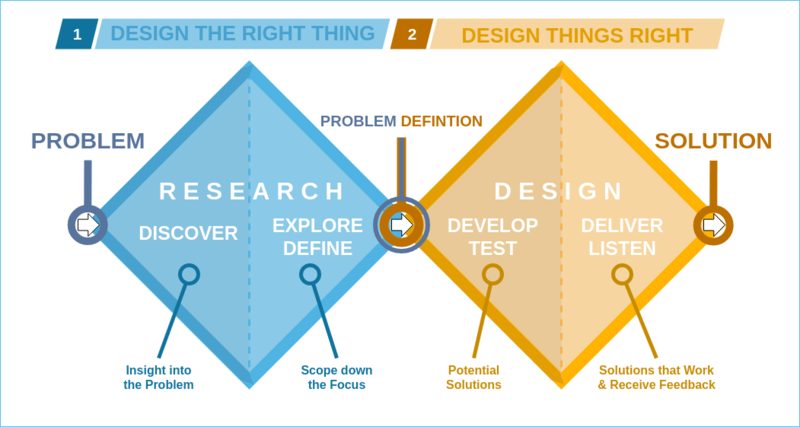Double diamond design process
Contents |
[edit] Introduction
Double Diamond is a design process model developed in 2005 by the British Design Council. Using a double diamond diagram, the method breaks down the general design process into four specific phases - discover, define, develop and deliver.
It is a method for using design process visualisation in a graphical way. It was adapted from a model proposed in 1996 by the linguist Béla H Bánáthy. Bánáthy created an earlier version of the model (based on the same four phases) as a method for examining social systems design theory. His study, 'Designing Social Systems in a Changing World', introduced a diagram for a divergence-convergence model which would form the basis of the double diamond design process.
[edit] Product and service development tool
As a design process, double diamond emphasises problem analysis as the basis for creating a solution for the client. Its development was based on case studies gathered from the design departments at 11 global firms:
- Alessi
- BSkyB
- BT
- LEGO
- Microsoft
- Sony
- Starbucks
- Virgin Atlantic Airways
- Whirlpool Corporation
- Xerox
- Yahoo!
[edit] Examining the phases
[edit] Discover
The discovery phase is based on an idea that arises and is then explored through methods:
- Market research
- User research
- Managing information
- Design research
[edit] Define
The definition phase ties the findings of the discovery phase to business goals. The activities of this phase include:
[edit] Develop
The development phase develops and tests solutions that are design based to see how they will actually suit the business goals. These activities include:
- Multi-disciplinary working
- Visual management
- Development methods
- Testing
[edit] Deliver
The delivery stage is marked by the introduction of the product or service that has been proposed. Activities during this stage include:
- Final testing, approval and launch
- Targets, evaluation and feedback loops
[edit] Related articles on Designing Buildings Wiki
- Analytic Hierarchy Process AHP.
- Case-based reasoning CBR.
- Concept design.
- Design.
- Design methodology.
- Evolutionary design process model EDPM.
- General design theory GDT.
- Product design requirements.
- What is design?
- What makes good design?
[edit] External resources
Featured articles and news
RTPI leader to become new CIOB Chief Executive Officer
Dr Victoria Hills MRTPI, FICE to take over after Caroline Gumble’s departure.
Social and affordable housing, a long term plan for delivery
The “Delivering a Decade of Renewal for Social and Affordable Housing” strategy sets out future path.
A change to adoptive architecture
Effects of global weather warming on architectural detailing, material choice and human interaction.
The proposed publicly owned and backed subsidiary of Homes England, to facilitate new homes.
How big is the problem and what can we do to mitigate the effects?
Overheating guidance and tools for building designers
A number of cool guides to help with the heat.
The UK's Modern Industrial Strategy: A 10 year plan
Previous consultation criticism, current key elements and general support with some persisting reservations.
Building Safety Regulator reforms
New roles, new staff and a new fast track service pave the way for a single construction regulator.
Architectural Technologist CPDs and Communications
CIAT CPD… and how you can do it!
Cooling centres and cool spaces
Managing extreme heat in cities by directing the public to places for heat stress relief and water sources.
Winter gardens: A brief history and warm variations
Extending the season with glass in different forms and terms.
Restoring Great Yarmouth's Winter Gardens
Transforming one of the least sustainable constructions imaginable.
Construction Skills Mission Board launch sector drive
Newly formed government and industry collaboration set strategy for recruiting an additional 100,000 construction workers a year.
New Architects Code comes into effect in September 2025
ARB Architects Code of Conduct and Practice available with ongoing consultation regarding guidance.
Welsh Skills Body (Medr) launches ambitious plan
The new skills body brings together funding and regulation of tertiary education and research for the devolved nation.
Paul Gandy FCIOB announced as next CIOB President
Former Tilbury Douglas CEO takes helm.
UK Infrastructure: A 10 Year Strategy. In brief with reactions
With the National Infrastructure and Service Transformation Authority (NISTA).

























Comments
I referenced this post here:
>>Where do ideas come from, and who owns them? (Specifically, the Double Diamond model)
short post with lots of comments: https://www.linkedin.com/posts/antlerboy_doublediamond-designthinking-servicedesign-activity-6795601313569882112-pEL_
full (short) research here: https://stream.syscoi.com/2021/05/05/the-double-diamond-as-an-example-of-some-challenges-of-attribution-in-the-history-of-ideas/